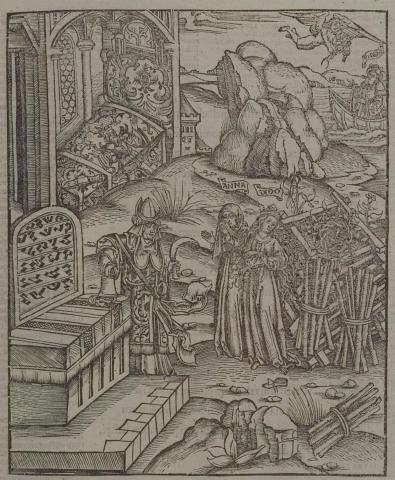Annotations
In the lower half of the image, Anna and Dido watch as a priest completes a sacrifice. To the left, the priest pours an offering of wine on the altar (452-55). To the right, Anna watches the sacrifice with a cloth covering her face while Dido looks over her shoulder at a pyre behind her that has not yet been lit (494-5, 505-7). In the upper left is the temple of Sychaeus, the late husband of Dido, whose image can be seen on the tomb, and whom Dido has heard calling to her at night (457-61). In the top right corner, winged Mercury advises Aeneas to leave Carthage before Dido decides to attack him with her ships (554-570). (Katy Purington)
Woodcut illustration from the “Strasbourg Vergil,” edited by Sebastian Brant: Publii Virgilii Maronis Opera cum quinque vulgatis commentariis expolitissimisque figuris atque imaginibus nuper per Sebastianum Brant superadditis (Strasbourg: Johannis Grieninger, 1502), fol. 224r, executed by an anonymous engraver under the direction of Brant.


Sebastian Brant (1458-1521) was a humanist scholar of many competencies. Trained in classics and law at the University of Basel, Brant later lectured in jurisprudence there and practiced law in his native city of Strasbourg. While his satirical poem Das Narrenschiff won him considerable standing as a writer, his role in the transmission of Virgil to the Renaissance was at least as important. In 1502 he and Strasbourg printer Johannes Grüninger produced a major edition of Virgil’s works, along with Donatus’ Life and the commentaries of Servius, Landino, and Calderini, with more than two hundred woodcut illustrations. (Annabel Patterson)